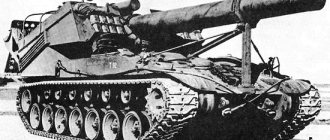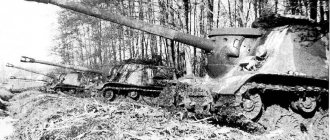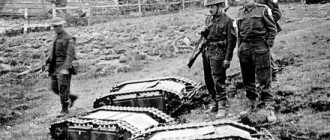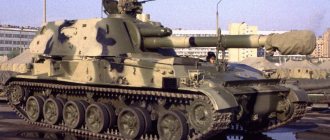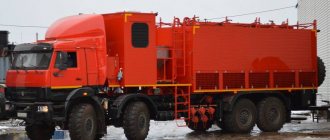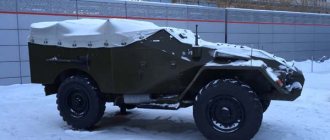Anti-aircraft self-propelled gun ZSU-23-4 Shilka (USSR)
At the end of the 50s. After the Soviet Army adopted high-precision anti-aircraft missiles, foreign aviation specialists urgently had to develop new tactics. Pilots were asked to fly at extremely low altitudes to avoid detection by new air defense systems. During this period, the standard air defense system for the troops was the ZSU-57-2, but it could not cope with the new task, so it was urgently necessary to develop a more modern self-propelled anti-aircraft gun. Such a vehicle appeared in 1964. It was a ZSU-23-4 Shilka . ZSU-23-4 Shilka is designed for direct cover of ground forces, destruction of air targets at ranges up to 2500 meters and altitudes up to 1500 meters, flying at speeds up to 450 m/s, as well as ground (surface) targets at ranges up to 2000 meters from a standstill , from a short stop and on the move.
The welded body of the TM-575 tracked vehicle is divided into three control compartments in the bow, a combat compartment in the middle and a power compartment in the stern. Between them there were partitions that served as the front and rear supports of the tower. The tower is a welded structure with a ring diameter of 1840 mm. It is attached to the frame by the front frontal plates, on the left and right walls of which the upper and lower gun cradles are attached. When the swinging part of the gun is given an elevation angle, the embrasure of the frame is partially covered by a movable shield, the roller of which slides along the guide of the lower cradle.
On the right side plate there are three hatches, one, with a bolted cover, is used for mounting turret equipment, the other two are closed with a visor and are air inlets for ventilation of units and superchargers of the PAZ system. A casing is welded to the outside of the left side of the turret, designed to remove steam from the gun barrel cooling system. There are two hatches in the rear turret for servicing equipment.
The turret is equipped with a 23-mm quad gun AZP-23 "Amur" with a rate of fire of 11 rounds per second each. Together with the turret, it was assigned the index 2A10, the gun automata - 2A7, and the power drives - 2E2. The automatic operation of the gun is based on the removal of powder gases through a side hole in the barrel wall. The barrel consists of a pipe, cooling system casings, a gas chamber and a flame arrester. The valve is wedge, with the wedge lowering down. The length of the machine gun with a flame arrester is 2610 mm, the length of the barrel with a flame arrester is 2050 mm (without a flame arrester - 1880 mm). The length of the threaded part is 1730 mm. The weight of one machine gun is 85 kg, the weight of the entire artillery unit is 4964 kg. It can fire with all four guns, or with a pair or any of the four. The gun barrels and the antenna of the radar-instrument complex are completely stabilized, thanks to which the installation can fire effectively while moving.
The cartridges are fed from the side, chambering is direct, directly from the link with the cartridge skewed. The right-hand machines have a right-hand tape feed, the left-hand ones - a left-hand feed. The tape is fed into the receiving windows of the machines from the cartridge box. For this purpose, the energy of powder gases is used, driving the feed mechanism through the bolt frame, and partly the recoil energy of the machine guns. The gun is equipped with two boxes of 1000 rounds of ammunition (of which the upper machine gun has 480, and the lower machine has 520 rounds) and a pneumatic reloading system for cocking the moving parts of the machine guns in preparation for firing and reloading in case of misfires.
Two machines are mounted on each cradle. Two cradles (upper and lower) are mounted on the frame, one above the other, at a distance of 320 mm from each other in a horizontal position, the lower one is extended forward in relation to the upper one by 320 mm. The parallelism of the trunks is ensured by a parallelogram rod connecting both cradles.
The gun's ammunition load includes 23-mm BZT and OFZT shells. Armor-piercing BZT shells weighing 190 g do not have a fuse or explosive, but only contain an incendiary substance for tracing. OFZT fragmentation shells weighing 188.5 g have an MG-25 head fuse. The propellant charge for both projectiles is the same - 77 g of 5/7 TsFP grade gunpowder. Cartridge weight 450 g. Steel sleeve, disposable. The ballistic data of both projectiles are the same - initial speed 980 m/s, table ceiling 1500 m, table range 2000 m. OFZT projectiles are equipped with self-liquidating devices with an action time of 5-11 s. The machine guns are powered by a belt, for 50 rounds. The belt alternates four OFZT cartridges - one BZT cartridge, etc.
Guidance and stabilization of the AZP-23 gun is carried out by 2E2 power guidance drives. The 2E2 system used a URS (Jenny coupling) for horizontal guidance - URS No. 5, and for vertical guidance - URS No. 2.5. Both operate from a common DSO-20 electric motor with a power of 6 kW.
Depending on external conditions and the state of the equipment, firing at anti-aircraft targets is carried out in four modes. The first (main) is the auto-tracking mode, angular coordinates and range are determined by the radar, which automatically tracks the target along them, providing data to the computing device (analog computer) for generating pre-emptive coordinates. Fire is opened upon the “Data available” signal on the counting device. The RPK automatically generates full pointing angles, taking into account the pitching and yaw of the self-propelled gun and sends them to the guidance drives, and the latter automatically point the gun at the lead point. Firing is carried out by the commander or search operator - gunner.
The second mode - angular coordinates come from the sighting device, and the range - from the radar. The angular current coordinates of the target are supplied to the calculating device from the sighting device, which is guided by the search operator - the gunner - automatically, and the range values come from the radar. Thus, the radar operates in radio range finder mode. This mode is auxiliary and is used in the presence of interference that causes malfunctions in the operation of the antenna guidance system along angular coordinates, or, in the event of a malfunction in the auto-tracking channel, along the angular coordinates of the radar. Otherwise, the complex works the same as in auto tracking mode.
The third mode—predicted coordinates are generated based on the “remembered” values of the current coordinates X, Y. H and the components of the target’s velocity, based on the hypothesis of uniform rectilinear motion of the target in any plane. The mode is used when there is a threat of losing a radar target during automatic tracking due to interference or malfunctions.
The fourth mode is shooting using a backup sight, aiming is carried out in semi-automatic mode. The lead is introduced by the search operator - the gunner using the angle rings of the backup sight. This mode is used when the radar, computer and stabilization systems fail.
The radar-instrument complex is designed to control the fire of the AZP-23 cannon and is located in the instrument compartment of the tower. It consists of a radar station, a computing device, blocks and elements of stabilization systems for the line of sight and line of fire, and a sighting device. The radar station is designed to detect low-flying high-speed targets and accurately determine the coordinates of the selected target, which can be done in two modes: a) angular coordinates and range are tracked automatically, b) angular coordinates come from the sighting device, and range from the radar.
The radar operates in the 1-1.5 cm wavelength range. The choice of range is due to a number of reasons. Such stations have antennas with small weight and dimensions. Radars in the 1-1.5 cm wavelength range are less susceptible to deliberate enemy interference, since the ability to operate in a wide frequency band allows, by using broadband frequency modulation and signal coding, to increase noise immunity and the processing speed of received information. By increasing the Doppler frequency shifts of reflected signals arising from moving and maneuvering targets, their recognition and classification is ensured. In addition, this range is less loaded with other radio equipment. Radars operating in this range make it possible to detect air targets developed using stealth technology. According to foreign press information, during Operation Desert Storm, the Iraqi ZSU-23-4 Shilka shot down an American F-117A aircraft built using this technology.
The disadvantage of radar is its relatively short range, usually not exceeding 10-20 km and depending on the state of the atmosphere, primarily on the intensity of precipitation - rain or sleet. To protect against passive interference, the ZSU-23-4 Shilka radar uses a coherent-pulse target selection method, i.e., constant signals from terrain objects and passive interference are not taken into account, and signals from moving circuits are sent to the RPK. The radar is controlled by the search operator and the range operator.
The ZSU-23-4 Shilka is equipped with an 8D6 diesel engine, which was given the designation B-6R by the manufacturer for installation on the GM-575. On machines manufactured since 1969, the V-6R-1 engine was installed, which had minor design changes. The V-6R engine is a six-cylinder, four-stroke, compressorless, liquid-cooled diesel engine that develops a maximum power of 206 kW at 2000 rpm. The working volume of the cylinders is 19.1 liters, the compression ratio is 15.0.
The GM-575 tracked chassis is equipped with two welded aluminum alloy fuel tanks: a front one with a capacity of 405 liters and a rear one with a capacity of 110 liters. The first is located in a separate compartment of the bow of the hull.
In the rear part of the hull there is a mechanical power transmission, with a stepwise change in gear ratios. The main clutch is multi-disc, dry friction. The main clutch control drive is mechanical, from the pedal at the driver's seat. The gearbox is a mechanical three-way, five-speed, with synchronizers in 2.3 4th and 5th gears. The rotation mechanisms are planetary, two-stage, with locking clutches. Final drives are single-stage with spur gears.
The chassis of the machine consists of two drive wheels, two guide wheels with a track tensioning mechanism, two track chains and twelve support wheels. The drive wheels are welded, with removable rims, rear-mounted. Single guide wheels with metal arches. The support rollers are welded, single, with rubberized rims. The caterpillar chain is metal, with lantern engagement, with closed hinges, made of 93 steel tracks connected to each other by steel pins. Track width 362 mm, track pitch 128 mm.
The vehicle's suspension is independent, asymmetrical torsion bar, with hydraulic shock absorbers on the first front, fifth left and sixth right road wheels; spring stops on the first, third, fourth, fifth, sixth left track rollers and the first, third, fourth and sixth right track rollers.
The power supply system is designed to power all ZSU-23-4 consumers with direct current voltages of 55 V and 27.5 V. and alternating current voltage 220 V, frequency 400 Hz.
The ZSU-23-4 Shilka is equipped with a short-wave frequency-modulated telephone transceiver radio station R-123. Its range of action in moderately rough terrain with the noise suppressor turned off and no interference is up to 23 km, and with the noise suppressor turned on - up to 13 km. For internal communication, a tank intercom P-124 for 4 subscribers is used.
ZSU-23-4 Shilka is equipped with TNA-2 navigation equipment. Its arithmetic mean error in generating coordinates as a percentage of the distance traveled is no more than 1%. When the ZSU is moving, the duration of operation of the equipment without reorientation is 3-3.5 hours.
The crew is protected from radioactive dust by cleaning the air and creating excess pressure in the fighting compartment and control compartment. For this purpose, a central supercharger with inertial air segmentation is used.
Shilka went into serial production of the ZSU-23-4 in 1964. That year it was planned to produce 40 vehicles, but this was not possible. However, mass production of the ZSU-23-4 was later launched. During the 60s, their average annual production was about 300 cars.
ZSU-23-4 Shilka began to enter service with the troops in 1965 and by the beginning of the 70s they completely replaced the ZSU-57-2. Initially, the statewide tank regiment had a “Shilok” division, which consisted of two batteries of four vehicles each. At the end of the 60s, it often happened that in a division one battery had a ZSU-23-4 and one battery had a ZSU-57-2. Later, motorized rifle and tank regiments received a standard anti-aircraft battery, consisting of two platoons. One platoon had four Shilka self-propelled air defense systems, and the other had four Strela-1 self-propelled air defense systems (then Strela-10 air defense systems).
Operation of the ZSU-23-4 Shilka showed that the RPK-2 works well under conditions of passive interference. There was practically no active jamming of the Shilka during our exercises, since there were no radio countermeasures at its operating frequencies, at least in the 70s. Significant shortcomings of the PKK were also revealed, which often needed reconfiguration. Instability of the electrical parameters of the circuits was noted. The RPK could take the target for auto tracking no closer than 7-8 km from the ZSU. At shorter distances this was difficult to do due to the high angular velocity of the target. When switching from detection mode to auto-tracking mode, the target was sometimes lost.
In the second half of the 60s, the ZSU-23-4 self-propelled gun underwent two small modernizations, the main purpose of which was to increase the reliability of various components and assemblies, primarily the RPK. The vehicles of the first modernization received the index ZSU-23-4V, and the second - ZSU-23-4V1. The main tactical and technical characteristics of self-propelled guns remained unchanged.
In October 1967, a resolution of the Council of Ministers was issued on a more serious modernization of the ZSU-23-4 Shilka. Its most important part was the redesign of the 2A7 assault rifles and the 2A10 gun in order to increase the reliability and stability of the complex, increase the survivability of gun parts and reduce maintenance time. During the modernization process, the pneumatic charging of the 2A7 assault rifles was replaced by pyrocharging, which made it possible to exclude an unreliably operating compressor and a number of other components from the design. The welded coolant drain pipe was replaced with a flexible pipeline - this increased the barrel life from 3500 to 4500 shots. In 1973, the modernized ZSU-23-4M was accepted for service along with the 2A7M assault rifle and the 2A10M cannon. ZSU-23-4M received the designation “Biryusa”, but in the army units it was still called “Shilka”.
After the next modernization, the anti-aircraft self-propelled gun will receive the index ZSU-23-4M3 (3 - interrogator). For the first time, “friend or foe” identification equipment was installed on it. Later, during repairs, all ZSU-23-4M were brought to the level of ZSU-23-4M3. Production of the ZSU-23-4M3 ceased in 1982.
There are different points of view on the effectiveness of the Shilka in the fight against air targets. Thus, during the 1973 war, Shilki accounted for about 10% of all Israeli aircraft losses (the rest were distributed between air defense systems and fighter aircraft). However, the pilots taken prisoner showed that the Shilkas literally created a sea of fire and the pilots instinctively left the ZSU fire zone and fell into the range of the air defense missile system. During Operation Desert Storm, pilots of the multinational forces tried not to operate unnecessarily at altitudes below 1300 m, fearing the fire of the ZSU-23-4 Shilka.
In Afghanistan, this ZSU fully realized the ability to fire at ground targets in the mountains. Moreover, a special “Afghan version” appeared - as it was no longer needed, the radio instrument complex was dismantled, due to which it was possible to increase the ammunition load from 2000 to 4000 rounds. A night sight was also installed on the vehicle.
"Shilkas" were widely exported to the Warsaw Pact countries, the Middle East and other regions. They took an active part in the Arab-Israeli wars, the Iraqi-Iranian war (on both sides), and the Gulf War in 1991.
Serial production of "Shilok" was completed in 1983. Currently, self-propelled guns of this type are in service in Afghanistan. Algeria, Angola. Bulgaria. Hungary, Vietnam, Egypt, Israel, India, Jordan, Iran, Iraq, Yemen, Congo, North Korea. Cuba, Laos, Libya, Nigeria, Peru, Poland. Russia, Syria, Somalia and Ethiopia.
Combat weight, t 19.0 Classic layout Crew, persons. 4 Hull length, mm 6535 Hull width, mm 3125 Height, mm 2500 Ground clearance, mm 400 Armor type rolled steel bulletproof (9-15mm) Armament Caliber and brand of gun 4 ? 23-mm AZP-23 “Amur” Gun type rifled automatic Barrel length, caliber 82 Gun ammunition 2000 VN angles, deg. ?4…+85 Sights optical sight, RPK-2 radar Engine type in-line 6-cylinder diesel liquid cooling Engine power, l. With. 280 Speed on the highway, km/h 50 Speed on rough terrain, km/h 25—30 Cruising range on the highway, km 450 Cruising range on rough terrain, km 300 Specific power, l. s./t 14.7 Suspension type individual torsion bar Climbability, degrees. 30 Wall to be overcome, m 0.7 Ditch to be overcome, m 2.5 Ford to be overcome, m 1.0
Syrian experience
The beginning of the civil war in Syria was marked by significant losses of Soviet-style military equipment. The Syrian army, which had previously trained exclusively in battles with an enemy equipped with a large number of armored vehicles and aircraft, suffered defeat after defeat in urban battles with militants. It took years before the shock troops of the Republican Guard and the Syrian Army were able to develop new urban combat tactics, adapting to the enemy's methods of warfare. Here the Shilkas entered the battle again.
Heavy losses forced the Syrian army to begin producing “carts” and handicraft armored vehicles. Anti-aircraft guns were added to tanks and armored cars in urban battles. Numerous modifications have appeared, in particular due to the use of protective screens and additional armor sheets that protect against grenade launchers. Radar antennas were removed from many vehicles, which are not needed in urban battles. The towers were surrounded by another layer of lattice or solid protection.
Shaitan-arba
In Afghanistan, our military was delighted with the Shilka. A column is walking along the road, and suddenly there is fire from an ambush. Try to organize a defense when all the vehicles have already been shot by the enemy. There is only one salvation - “Shilka”. A long line - and a sea of fire at the enemy position. The dushmans called our self-propelled gun “shaitan-arba”. They determined the beginning of her work immediately and immediately began to leave. “Shilka” saved the lives of thousands of Soviet soldiers.
Two in one MANPADS 9K310 “Igla-1” is capable of hitting airplanes, helicopters, and remotely piloted aircraft at a distance of 5.2 km.
There was even a special “Afghan version” of the Shilka, the ZSU-23−4M2. As it was no longer needed, the radio instrument complex was dismantled, due to which it was possible to increase the ammunition load from 2000 to 4000 rounds. A night sight was also installed.
Gadfly, Shilka's friend
Nevertheless, they did not write off the Shilki. Since the beginning of the 1990s, the main thing for the development of self-propelled guns has become not an increase in the rate of fire and the effectiveness of projectiles, but the ability to detect low-flying high-speed targets in conditions of passive-active interference, as well as a greater likelihood of surviving massive enemy air raids.
2K22 "Tunguska" The 2K22 "Tunguska" (SA-19 Grison) anti-aircraft missile and gun system is perhaps the most powerful air defense missile and artillery weapon.
Since the Shilok’s ability to detect air targets is limited, work began back in 1971 on the creation of a special “control point for an air defense unit of a motorized rifle (tank) regiment.” The installation, called Ovod-M-SV, was created on the MTL-BU tracked armored chassis and was intended to control the fire of the Shilok and the Strela-1M air defense system. The Gadfly was equipped with the Luk-23 radar, an automatic fire control system for the ZSU and air defense systems, interfaced with the division's air defense system, and was put into service in 1978 under the name PPRU-1 (mobile reconnaissance and control unit).
Since the mid-1990s, the Ulyanovsk Mechanical Plant has been modernizing the Shilka ZSU in the Shilka M4 version (ZSU-23−4M4 and ZSU-23−4M5) with a radar fire control system and the Shilka M5 with radar and optical location systems fire control. New modifications of the ZSU are effective against targets flying at altitudes from 25 m to 1500 m (ZSU-23−4M4) or from 0 m to 1500 m (ZSU-23−4M5), at a range of up to 2500 m, while the speed of the target being hit can reach 500 m/s.
Interesting Facts
Samples of the ZSU-23-4 Shilka, which fell into the hands of the Americans during the Arab-Israeli War, were used in the first half of the 1970s in comparative survivability tests of two direct support aircraft of the US ground forces A-10 and A-7 " Corsair II." Based on the test results, it was established that the combat survivability of the A-10 attack aircraft was determined in relation to 23 mm caliber ammunition. Subsequently, the potential enemy’s presence of an armored attack aircraft that was not hit by standard 23 mm military air defense systems contributed to the intensification of work in the USSR on the creation of 30 mm anti-aircraft systems (see Tunguska).
Production and export
A crew of ZU-23-2 from the Separate Operational Division during complex training of operational and special purpose units dedicated to the Day of Internal Troops of the Ministry of Internal Affairs of the Russian Federation.
The production of the anti-aircraft gun was carried out in the USSR, and then in a number of countries, including Egypt, Iran, the Czech Republic, Slovakia, Bulgaria and Finland. In China, production was only for export.
: In the Soviet Union, the production of the installation was established by the following military industry enterprises:
- Plant No. 525, Kuibyshev
- Plant No. 535, Tula
The production of 23-mm shells was carried out:
- Plant No. 184, Zelenodolsk, Tatar ASSR
- Plant No. 398, Dzerzhinsk, Gorky region.
Russia: in Russia, production is closed, but in 2020, previously built installations are being modernized and new barrels are being produced.
Production in other countries
In socialist countries and socialist-oriented countries, production was established by the following enterprises:
Poland: Tarnow Mechanical Plant, Tarnow.
Factories of the Northern Industrial Corporation
- Type 80
23mm twin anti-aircraft gun (replica) - 25-mm twin anti-aircraft gun Type 87
for the 25-mm Oerlikon projectile (modification)
Bulgaria: produced in 2 versions: for ground forces and for the fleet.
The production of 23-mm ZU-23-2 ammunition was carried out at various times by Egypt, Iran, Israel, France, Finland, the Netherlands, Switzerland, Bulgaria, Yugoslavia and South Africa.
In service
- Algeria: 100 ZU-23, as of 2020.
- Angola: some ZU-23-2, as of 2017.
- Armenia: some ZU-23-2, as of 2017.
- Bulgaria: some ZU-23, as of 2007.
- Bosnia and Herzegovina: 29 ZU-23, as of 2020. 19 ZU-23-2, as of 2007.
- Burundi: some ZU-23, as of 2017.
- Venezuela: 200 ZU-23-2, as of 2020.
- Djibouti: 5 ZU-23, as of 2020. 5 ZU-23-2, as of 2007.
- Egypt: 200 ZU-23-2, as of 2020.
- Gabon: 24 ZU-23-2, as of 2020.
- Ghana: 4 ZU-23-2, as of 2020.
- Guinea-Bissau: 18 ZU-23, as of 2020. 18 ZU-23-2, as of 2007.
- Greece: 523 ZU-23-2, as of 2020 (306 of them received free of charge from the German government from the arsenals of the former NNA of the GDR after its disbandment).
- Zimbabwe: 45 ZU-23, as of 2020. 45 ZU-23-2, as of 2007.
- Israel: 150 ZU-23-2, as of 2020. a number in service with the Air Force, as of 2007. 50 ZU-23-2, as of 1994.
- India: >320 ZU-23-2, as of 2020.
- Iraq: some ZU-23-2, as of 2020. a number in the army, as of 2015.
Iraqi Kurdistan: 5 ZU-23-2, delivered in March 2020.
- Iran: >300 ZU-23-2, as of 2020. ~300 units for 2020; We have our own production of ZU-23-2.
- Cape Verde: 12 ZU-23, as of 2020. 12 ZU-23-2, as of 2007.
- DPRK: a number of ZU-23, as of 2017.
- Cote d'Ivoire: some ZU-23-2, as of 2017.
- Cuba: some ZU-23, as of 2017.
- Laos: some ZU-23, as of 2017.
- Lebanon: 57 ZU-23-2, as of 2020.
- Libya: some ZU-23-2, as of 2017.
- Mauritania: 20 ZU-23-2, as of 2020.
- Morocco: 75-90 ZU-23-2, as of 2020.
- Mozambique: 120 ZU-23-2, as of 2020.
- Moldova: 28 ZU-23, as of 2020. 26 ZU-23-2, as of 2007.
- Mongolia: some ZU-23, as of 2017.
- Nigeria: some ZU-23, as of 2017.
- Nicaragua: 18 ZU-23, as of 2020. 18 ZU-23-2, as of 2007.
- Oman: 4 ZU-23-2, as of 2020.
- Peru: 80 ZU-23-2 and 50 ZU-23, as of 2020.
- Poland: 252 ZU-23-2 and 72 ZUR-23-2KG/PG, as of 2017.
- Russia.
- Syria: some ZU-23-2, as of 2020. 600 ZU-23-2, as of 2007.
- Sudan: 50 ZU-23-2, as of 2020.
- Tanzania: 40 ZU-23, as of 2020. 40 ZU-23-2 in service with the Air Force, as of 2007.
- Ukraine: some ZU-23-2, as of 2017.
- Finland: some ZU-23-2, as of 2017.
- Chad: some ZU-23, as of 2020.
- Eritrea: some ZU-23, as of 2017.
- Ecuador: 34 ZU-23, as of 2020. 34 ZU-23-2, as of 2007.
- Estonia
- Ethiopia: some ZU-23, as of 2017.
- South Sudan: some ZU-23-2 as of 2018
Former operators
- Azerbaijan: some as of 2007.
- Afghanistan: some, as of 2007.
- Belarus: some
- Vietnam: a number of ZU-23-2 are in service with air defense patrol ships of Project 159A [ source not specified 2930 days
] - Yemen: 100 ZU-23-2, as of 2007.
- China: some, as of 2007.
- PMR
Analogs
- 53T2 (Tarasque) - French 20-mm anti-aircraft gun;
- M621 CP 20 - French 20mm vehicle mount;
- Flugabwehrkanone 20 mm Zwilling - German 2 × 20 mm Rh202 gun (20 × 139 mm);
- Oerlikon GAI-BO1 - Swiss 20-mm anti-aircraft gun;
- Oerlikon GAI DOI - Swiss twin 20-mm anti-aircraft gun (20x139 mm);
- YW 306 - Chinese 23 mm copy of ZU-23-2;
- M55 - Yugoslav towed triple 20-mm anti-aircraft gun (20x110 mm).
- TCM-20 is a twin 20-mm Israeli installation of Hispano-Suiza HS.404 cannons based on the American M45 Quadmount anti-aircraft machine gun (20x110 mm).
- A436 M1980 - Romanian towed 30 mm anti-aircraft artillery mount.
